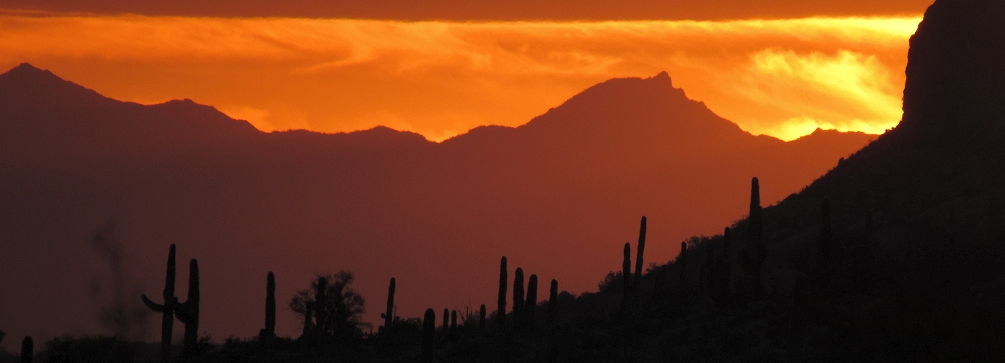Hiking the Superstition Mountains
Trails of Arizona’s Desert Wilderness

Hiking the Superstitions video playlist

The Superstitions, or “Supes” as they are often called by locals, rise like a rampart to the east of Phoenix’s Valley of the Sun. It’s said that nineteenth century settlers in the area believed the indigenous peoples to be “superstitious” about entering the mountains hence their name.
The mountainous core of the Superstitions is protected in the Superstition Wilderness which was one of the first fifty-four areas that were set aside as wilderness under the 1964 Wilderness Act. The Superstition Wilderness embraces over 250 square miles of sculpted peaks, soaring pinnacles, and twisting canyons, and extends over an area larger than Utah’s Zion National Park. The vast network of well developed mountain trails makes the Superstitions a haven for hiking aficionados and February offers near perfect conditions for exploring this mountain fastness. Spend your evenings at the very comfortable Valley Ho Hotel, a wonderfully restored mid-century modern gem adjacent to Scottsdale’s old town.
Plan some extra days before or after the trip to take in sights such as Frank Lloyd Wright’s Taliesen West, the Desert Botanical Garden, and Phoenix’s renowned Heard Museum.


The Valley Ho Hotel in Scottsdale provides comfort after a day on the trail!
Day 1
Overnight at the Valley Ho Hotel, Scottsdale
Dinner included
Plan your arrival at Phoenix Sky Harbor International Airport and travel to the Valley Ho Hotel in Scottsdale, eight miles from the airport, on your own. A taxi transfer to the Valley Ho Hotel can be arranged in advance (see “Other Information” on the right). A welcome dinner in Scottsdale is included this evening.


Saguaro cacti along the Second Water Trail, Superstition Mountains.

Saguaro “forest” along the Black Mesa Trail, Superstition Mountains.
Day 2
Overnight at the Valley Ho Hotel, Scottsdale
Breakfast and lunch included
Travel by vehicle east from Scottsdale to the First Water Trailhead on the western flanks of the Superstition Mountains. Then, set off on a hike that will take you through classic Sonoran desert mountain landscapes punctuated by the iconic, multi-armed forms of saguaro cacti. Traverse the wide open plain of the Garden Valley, then ascend easily to the top of Black Mesa through a beautiful saguaro “forest” with the blocky peaks of the Superstition Mountains rising to the south. Black lava boulders are strewn across Black Mesa’s flat top attesting to the ancient volcanic origins of the mountains. The unmistakable form of the slender rocky pinnacle known as the Weavers Needle punctuates the skyline to the southeast. The shorter option hike ends here and returns via the same route to the trailhead. For a longer hike, continue from Black Mesa into Boulder Canyon close by the aptly named yellow walls of Yellow Mountain. The trail then begins a gentle ascent to Parker Pass with ever-changing views of Weavers Needle. The last portion of the hike descends to the northwest following the course of the First Water Creek. Rocky outcroppings frame the trail and, perhaps, the gentle music of a desert stream serenades you back to the starting point. Return to Scottsdale by vehicle after the hikes.

The distinctive spire of Weavers Needle seen from Black Mesa, Superstition Mountains.

View of the Weavers Needle from Parker Pass, Superstition Mountains.


Ramparts of the Dacite Cliffs near Peralta Trailhead, Superstition Mountains.

Weavers Needle from Fremont Saddle, Superstition Wilderness.
Day 3
Overnight at the Valley Ho Hotel, Scottsdale
Breakfast, lunch and dinner included
After breakfast, set off for your second hiking adventure in the Superstition Wilderness. Travel to the Peralta Trailhead at the southwestern edge of the Superstition Mountains. Follow the Peralta Canyon Trail past rocky “hoo-doos” that stand like a crowd of sentinels keeping watch over the canyon. Gain the Fremont Saddle, a mountain pass that divides Peralta Canyon to the south and the East Boulder Canyon to the north. From this vantage point, a sudden and stunning view of the Weavers Needle presents itself. Stop for a rest and breathe deep of this glorious landscape! The short option hike retraces its steps to the trailhead from this point. Energetic hikers can continue beyond Fremont Saddle to begin a circumnavigation of the Weavers Needle. The Needle dominates the landscape from this point forward and it will be your near constant companion throughout the day offering you different views of its graceful form. From Fremont Saddle the trail drops into East Boulder Canyon before making its way toward the rosy red peak of Palomino Mountain. As it swings around to the east side of Weavers Needle the trail follows a roller-coaster course over the Terrapin Pass and Bluff Saddle. The views never stop! As it nears its end, the trail drops into Barks Canyon and then makes a final ascent to a bluff above the canyon where magnificent views open up eastward toward the west face of the Miner’s Needle glowing in the later afternoon sunshine. A final switchbacking descent brings you back to the Peralta Trailhead. Travel back to Scottsdale for the evening.

Golden walls of Black Top Mesa rising out of Boulder Canyon.

View of the Superstition Mountains from Terrapin Pass.

Day 4
Departure from Scottsdale
Breakfast included
Travel to Phoenix Sky Harbor International Airport on your own. A taxi transfer from the Valley Ho Hotel can be arranged in advance. Phoenix Airport is only eight miles from Scottsdale.

A blazing Arizona sunset, First Water Trailhead, Superstition Mountains.

Other Resources
![]() Check out the Arizona Wildflowers page on the American Southwest website for a sampling of the floral richness of the Arizona desert.
Check out the Arizona Wildflowers page on the American Southwest website for a sampling of the floral richness of the Arizona desert.

Desert Aster (Xylorhiza tortifolia) in Peralta Canyon, Superstition Mountains.

Photos on this page are by John Osaki (© All Rights Reserved).








